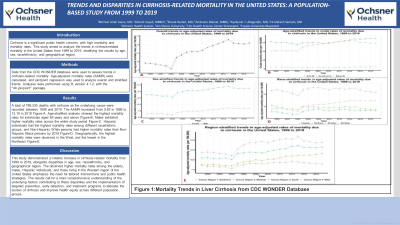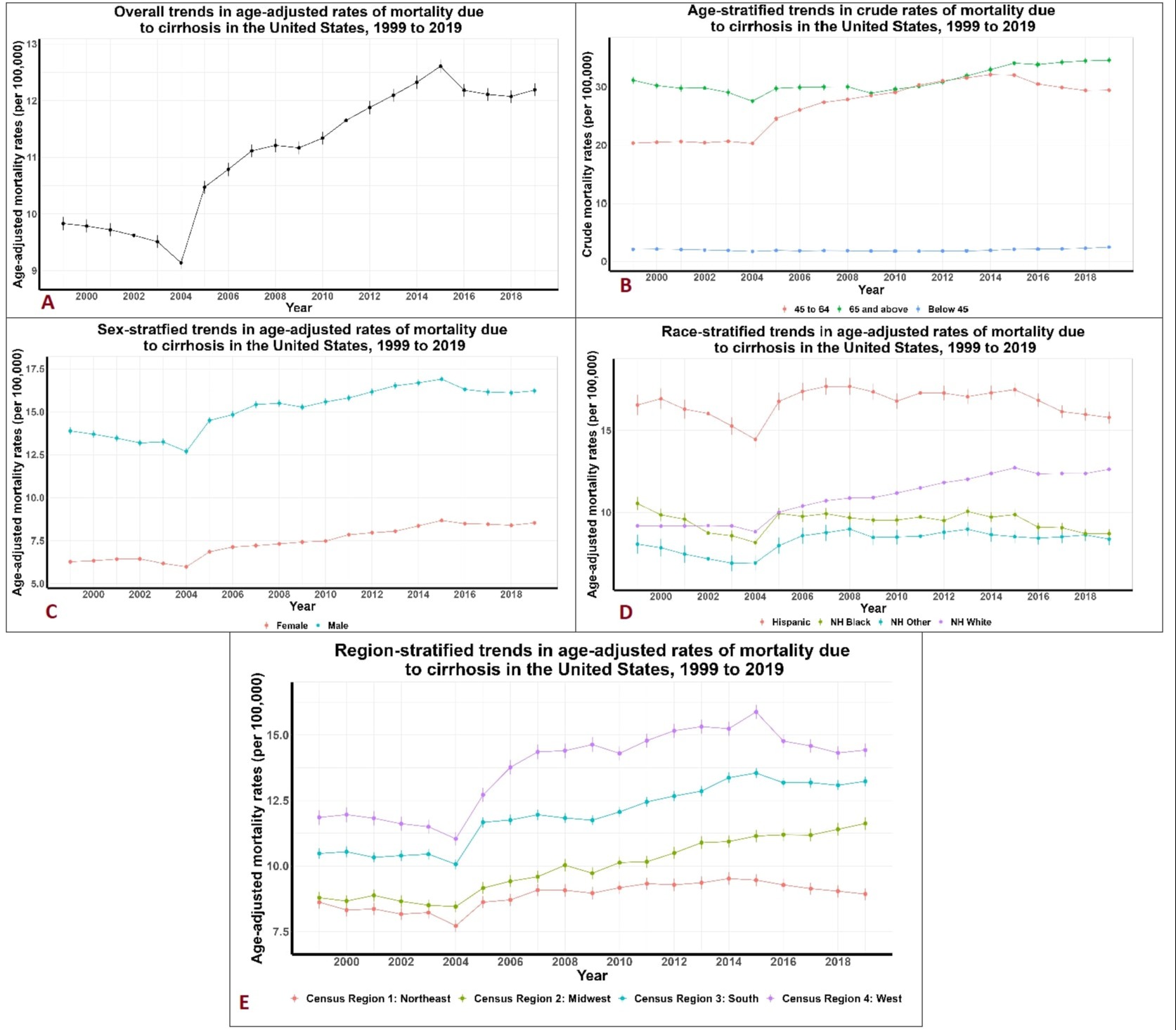Tuesday Poster Session
Category: Liver
P3846 - Trends and Disparities in Cirrhosis-Related Mortality in the United States: A Population-Based Study from 1999 to 2019
Tuesday, October 24, 2023
10:30 AM - 4:00 PM PT
Location: Exhibit Hall

Has Audio

Shazia Rashid, MD
LSU Health Sciences Center
Shreveport, LA
Presenting Author(s)
Rehmat Ullah Awan, MD1, Ahmed Sayed, MBBCh2, Shazia Rashid, MD3, Ambreen Nabeel, MBBS1, Ayokunle T.. Abegunde, MD4, Hrishikesh Samant, MD5
1Ochsner Rush Medical Center, Meridian, MS; 2Ain Shams University, Cairo, Al Qahirah, Egypt; 3LSU Health Sciences Center, Shreveport, LA; 4Loyola University Medical Center, Maywood, IL; 5Ochsner Medical Center, New Orleans, LA
Introduction: Cirrhosis is a significant public health concern, with high morbidity and mortality rates. This study aimed to analyze the trends in cirrhosis-related mortality in the United States from 1999 to 2019, stratifying the results by age, sex, race/ethnicity, and geographical region.
Methods: Data from the CDC WONDER database were used to assess trends in cirrhosis-related mortality. Age-adjusted mortality rates (AAMR) were calculated, and jointpoint regression was used to analyze overall and stratified trends. Analyses were performed using R, version 4.1.2, with the "nih.joinpoint" package.
Results: A total of 789,335 deaths with cirrhosis as the underlying cause were recorded between 1999 and 2019. The AAMR increased from 9.83 in 1999 to 12.19 in 2019 Figure-A. Age-stratified analysis showed the highest mortality rates for individuals aged 65 years and above Figure-B. Males exhibited higher mortality rates across the entire study period Figure-C. Hispanic individuals had the highest mortality rates among different racial/ethnic groups, and Non-Hispanic White persons had higher mortality rates than Non-Hispanic Black persons by 2019 Figure-D. Geographically, the highest mortality rates were observed in the West, and the lowest in the Northeast Figure-E.
Discussion: This study demonstrated a notable increase in cirrhosis-related mortality from 1999 to 2019, alongside disparities in age, sex, race/ethnicity, and geographical region. The observed higher mortality rates among the elderly, males, Hispanic individuals, and those living in the Western region of the United States emphasize the need for tailored interventions and public health strategies. The results call for a more comprehensive understanding of the underlying factors contributing to these disparities and the implementation of targeted prevention, early detection, and treatment programs to alleviate the burden of cirrhosis and improve health equity across different population groups.

Disclosures:
Rehmat Ullah Awan, MD1, Ahmed Sayed, MBBCh2, Shazia Rashid, MD3, Ambreen Nabeel, MBBS1, Ayokunle T.. Abegunde, MD4, Hrishikesh Samant, MD5. P3846 - Trends and Disparities in Cirrhosis-Related Mortality in the United States: A Population-Based Study from 1999 to 2019, ACG 2023 Annual Scientific Meeting Abstracts. Vancouver, BC, Canada: American College of Gastroenterology.
1Ochsner Rush Medical Center, Meridian, MS; 2Ain Shams University, Cairo, Al Qahirah, Egypt; 3LSU Health Sciences Center, Shreveport, LA; 4Loyola University Medical Center, Maywood, IL; 5Ochsner Medical Center, New Orleans, LA
Introduction: Cirrhosis is a significant public health concern, with high morbidity and mortality rates. This study aimed to analyze the trends in cirrhosis-related mortality in the United States from 1999 to 2019, stratifying the results by age, sex, race/ethnicity, and geographical region.
Methods: Data from the CDC WONDER database were used to assess trends in cirrhosis-related mortality. Age-adjusted mortality rates (AAMR) were calculated, and jointpoint regression was used to analyze overall and stratified trends. Analyses were performed using R, version 4.1.2, with the "nih.joinpoint" package.
Results: A total of 789,335 deaths with cirrhosis as the underlying cause were recorded between 1999 and 2019. The AAMR increased from 9.83 in 1999 to 12.19 in 2019 Figure-A. Age-stratified analysis showed the highest mortality rates for individuals aged 65 years and above Figure-B. Males exhibited higher mortality rates across the entire study period Figure-C. Hispanic individuals had the highest mortality rates among different racial/ethnic groups, and Non-Hispanic White persons had higher mortality rates than Non-Hispanic Black persons by 2019 Figure-D. Geographically, the highest mortality rates were observed in the West, and the lowest in the Northeast Figure-E.
Discussion: This study demonstrated a notable increase in cirrhosis-related mortality from 1999 to 2019, alongside disparities in age, sex, race/ethnicity, and geographical region. The observed higher mortality rates among the elderly, males, Hispanic individuals, and those living in the Western region of the United States emphasize the need for tailored interventions and public health strategies. The results call for a more comprehensive understanding of the underlying factors contributing to these disparities and the implementation of targeted prevention, early detection, and treatment programs to alleviate the burden of cirrhosis and improve health equity across different population groups.

Figure: Mortality Trends in Liver Cirrhosis from CDC WONDER Database
Disclosures:
Rehmat Ullah Awan indicated no relevant financial relationships.
Ahmed Sayed indicated no relevant financial relationships.
Shazia Rashid indicated no relevant financial relationships.
Ambreen Nabeel indicated no relevant financial relationships.
Ayokunle Abegunde indicated no relevant financial relationships.
Hrishikesh Samant indicated no relevant financial relationships.
Rehmat Ullah Awan, MD1, Ahmed Sayed, MBBCh2, Shazia Rashid, MD3, Ambreen Nabeel, MBBS1, Ayokunle T.. Abegunde, MD4, Hrishikesh Samant, MD5. P3846 - Trends and Disparities in Cirrhosis-Related Mortality in the United States: A Population-Based Study from 1999 to 2019, ACG 2023 Annual Scientific Meeting Abstracts. Vancouver, BC, Canada: American College of Gastroenterology.
